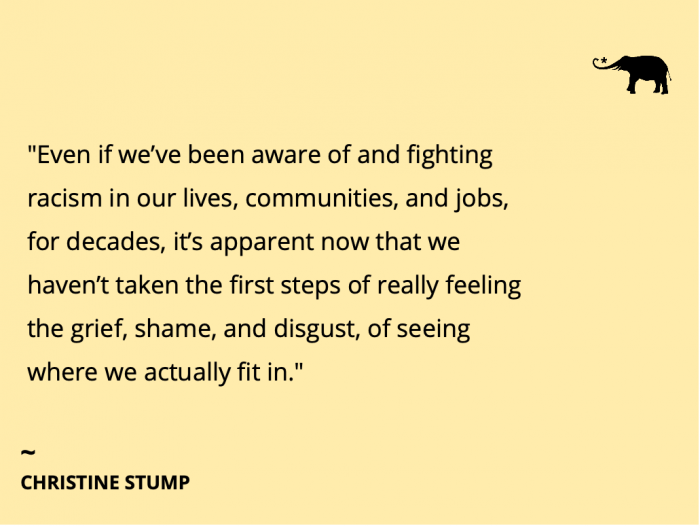Each first Friday, I facilitate a small group of yogis in discussing one chapter from Resmaa Menakem‘s My Grandmother’s Hands: Racialized Trauma and the Pathway to Mending our Hearts and Bodies.
In chapter 12, ‘The Wisdom of Clean Pain,’ everything revolved around discomfort. What is it? What do we do with it? Can we remain connected to ourselves through it? Can we remain connected to others during it?
The triad of connection to self, connection to others, and feeling discomfort, is at the heart of dismantling racist/white supremacist structures and impulses—in both our society and in ourselves.
When I first read this book, I suffered from the reflex that it would not be about me, because I am not racist. [Insert any of the myriad self-serving, reactionary reasons for believing that here: I support people of color; I have friends from varying ethnic backgrounds; I rally/call/support anti-racist causes.]
Menakem’s book broke down those reasons for me so thoroughly, methodically, historically, and completely that for a long time I could do nothing but sit with the discomfort of knowing the following things:
>> Structural racism/white supremacy is pervasive.
>> I am part of the society so structured.
>> I benefit from that structure. (I am a white person.)
>> I cannot stop benefiting from that structure simply by recognizing it.
>> As long as that structure exists, I will benefit.
>> This pervasive power relationship will take a long time to heave up.
I am essentially still sitting with that discomfort. In our monthly meetings we not only consider the transformative ideas in each chapter, discuss current events, and our experiences regarding race and justice, but also—and probably most importantly—we practice remaining connected to ourselves and to one another while we feel the discomfort of being in this social structure and realizing our part in it.
We practice not reacting immediately to that discomfort.
We are not trying to erase it, not trying to throw up quick fixes or our bona fides as non-complicit, but simply acknowledge the reality of this predicament that all white folks have allowed to linger, simply because we haven’t had the wisdom, or courage, or both, to allow ourselves to sit together long enough to really begin to feel the water we’ve been swimming in.
This group is a group of white yogis. It wasn’t planned that way, though it makes sense to me that it is.
We have many people of color in our community. As a white woman, I am not qualified to lead a group for people of color, and I’m probably not skilled enough to lead a group of both white folks and Black, Indigenous and people of color together. I find the de facto segregation both unsettling and understandable. Black, Indigenous and people of color have different experiences and needs around this work.
We have someone starting a Black, Indigenous and people of color based group soon.
Even if we’ve been aware of and fighting racism in our lives, communities, and jobs, for decades, it’s apparent now that we haven’t taken the first steps of really feeling the grief, shame, and disgust, of seeing where we actually fit in. It’s too easy to respond with: What can we do? How do we fix it? Where do we march? Find an injustice and try to right it. Become social workers, therapists, paramedics, teachers, and try to do our part.
All too often, this response—sometimes pursued through years and years of study and degrees—is, at least in part, a way to escape the deep pain of suspecting we have responsibility for white supremacy. We are responsible even if never asked for the benefits accruing to us.
Dr. John Deloney, a podcast host focusing on wellness through relationship, has a phrase that describes it well: not by my hand, but in my lap. Martin Heidegger, a highly regarded German philosopher, described this predicament of the human condition with the phrase (in English): always already being in progress.
The unexpected gift of this group—started as a response to George Floyd’s murder and the dizzying array of racial violence caught on cell cameras in the past year—is the opportunity to practice feeling this grief, shame, and disgust, while remaining connected to ourselves and connected to one another. We meet for a short time, once per month, focusing on a single chapter. It is slow work, and we often find that it takes the whole intervening month to integrate the experience.
Menakem’s distinction between clean and dirty pain (I think he originated it—I haven’t found a post about it prior to his 2017 book) illuminates the pathways we use to circumvent the process of actually feeling discomfort. Essentially, clean pain is pain we have felt by metabolizing it, and metabolizing pain can only be accomplished in connection: connection with self and connection with others.
This group has been a revelation of how being with one another and directing our attention to specific social structures, feeling our reactions to their existence, and our knowledge and embeddedness, is a more robust basis for action than I’ve found through decades of protest experience.
What do you do with your feelings when confronted with injustice in life, in history, in the news? How do you metabolize these experiences in your community? Have you read Menakem’s book?











Read 7 comments and reply